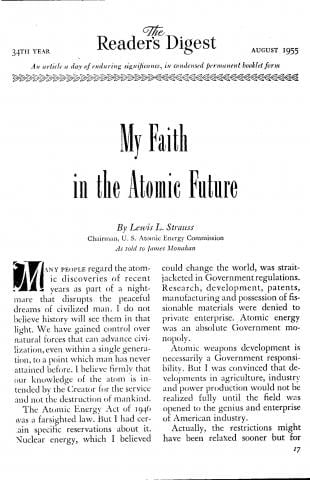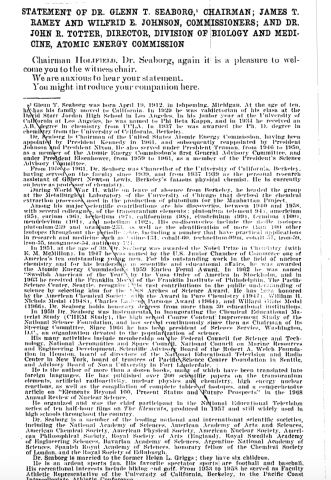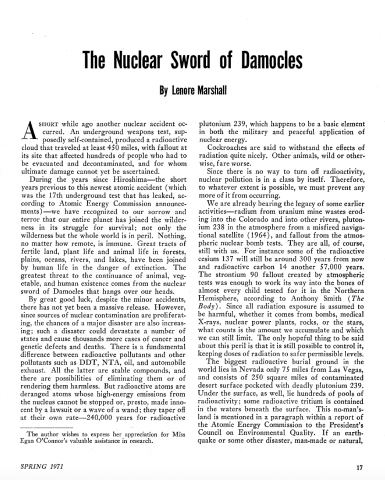Overview
Jim Feldman
Almost since its inception, nuclear technology has raised challenging questions about the goals, costs, and the very nature of progress. Would nuclear technologies lead to a world of cheap energy that freed humans from the demands of physical labor—or to a world of dystopic, technocratic rule and environmental ruin? The documents in this module provide a window into American ideas about nuclear energy, progress, and nature in the early years of the “Atomic Age.”
Americans first encountered nuclear energy a generation before World War II. European scientists such as Wilhelm Conrad Roentgen and Marie Curie had experimented with radioactivity and X-rays since the 1890s; Curie won two Nobel prizes for her explorations of radiation. Radium-infused paints hit the American market in the late 1910s and became key features on everything from watch dials to childrens’ toys, their glow-in-the-dark fluorescence representing the arrival of modernity. That the young women who applied radium paint to watch dials eventually suffered from radiation poisoning also came to stand for modernity’s mixed blessings. By the 1930s, radioactivity and atomic imagery claimed a central role in American thinking about science and technology, modernity and progress.
The bombing of Hiroshima and Nagasaki, however, represented something different, and forced the American public to grapple in new ways with both the promise and the almost inconceivable peril of nuclear energy. As the Cold War intensified in the 1950s, fear of nuclear annihilation dominated the public discourse about nuclear technologies. The negative consequences of nuclear weapons were clear to see; but what about other forms of nuclear technology?
American ideas about nuclear energy both shaped, and were shaped by, the modern environmental movement. In the early years of the Cold War, virulent anti-Communism suppressed concerns about potential negative impacts of both civilian and military nuclear technology. But in the late 1950s, the first public criticisms of nuclear energy built on a growing anxiety about the environmental impacts of fallout from weapons testing. This fear of fallout catalyzed the modern environmental movement. Scholars have suggested, for example, that Rachel Carson’s Silent Spring owed its popularity to a general public primed for her warnings about silent, deadly chemicals and her questions about the environmental costs of progress by their encounters with fallout.
As the environmental movement blossomed in the late 1960s, the focus of environmental concern broadened to include the commercial generation of nuclear energy as well as nuclear weapons. At the same time, the promoters of nuclear power viewed the technology a perfect response to newfound concerns about pollution and air quality. With rising costs of fossil fuels, concerns about the stability of the energy supply, and heavy government subsidies, many utility companies invested in the construction of nuclear generating stations.
At the heart of these debates lay fundamental questions about the nature of progress. What kind of promises did the American dream entail, exactly? What role might nuclear energy—and science and technology in general—play in the pursuit of progress? And what costs—environmental and otherwise—should people accept in this pursuit?
Cite this overview:
Feldman, Jim. “Overview: Nuclear Energy, the Environment, and Debating the Costs of Progress.” Energy History Online. Yale University. 2023. https://energyhistory.yale.edu/nuclear-energy-the-environment-and-debating-the-costs-of-progress/.
Library Items
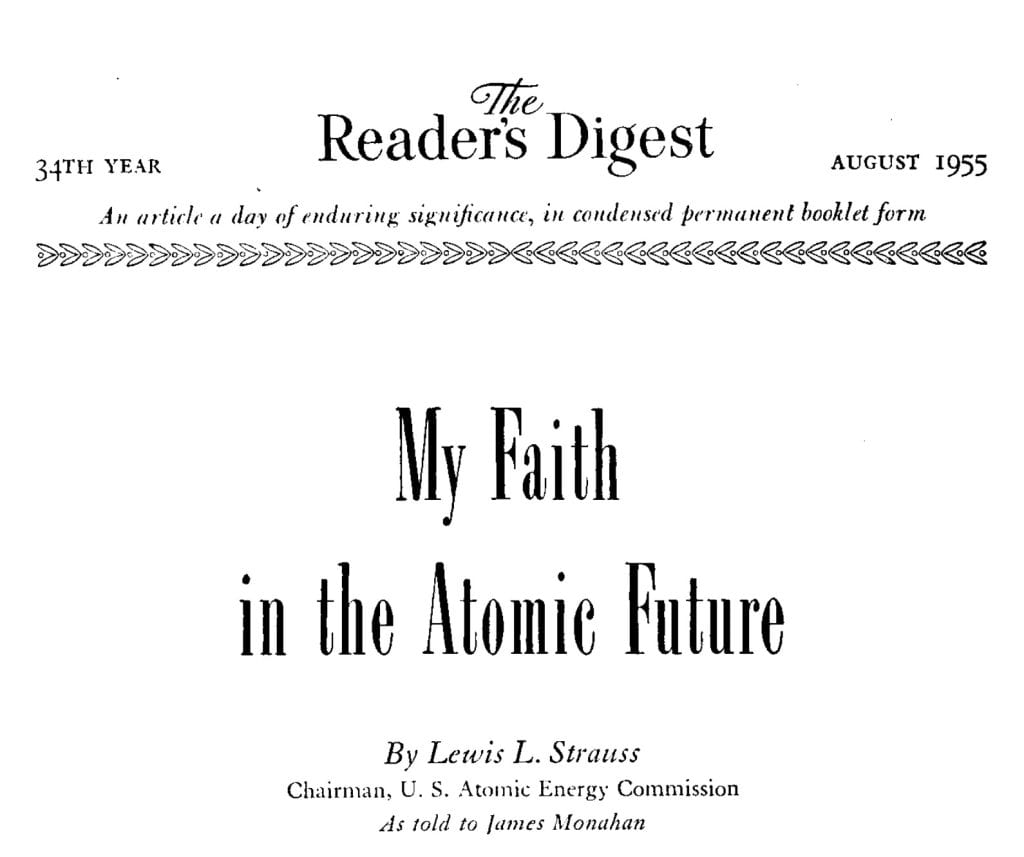
Lewis L. Strauss, “My Faith in the Atomic Future,” 1955
In 1953, President Eisenhower appointed Lewis Strauss chair of the Atomic Energy Commission. This 1955 article in Reader’s Digest, Strauss outlines his vision for the ways that atomic energy could be put to peaceful ends. What does Strauss have to say about the Soviet Union and the prospects of international pooling of nuclear technology? What about the role of private enterprise in developing atomic technology? What can his attitude tell us about the Cold War political climate of the 1950s?
SANE Protests the Arms Race, 1957
As the standoff between the United States and the Soviet Union intensified throughout the 1950s, both sides raced to develop increasingly powerful nuclear weaponry, including hydrogen bombs. In 1957, the National Committee for a SANE Nuclear Policy (SANE), a grassroots lobbying organization founded by the writers Lenore Marshall and Norman Cousins, took out full-page advertisements in newspapers around the United States.
Glenn T. Seaborg, “Environmental Effects of Producing Electric Power,” 1969
During his illustrious career, chemist Glenn Seaborg touched almost every aspect of American encounters with nuclear energy. In this congressional testimony from 1969, Seaborg describes nuclear power as the only viable solution to the world’s rapidly expanding energy requirements.
What are Seaborg’s views on the nascent environmentalist movement?
What can his testimony tell us about the ways that experts in the 1960s balanced concerns about the environment with concerns for energy production?
Lenore Marshall, “The Nuclear Sword of Damocles,” 1971
In the title of this article, poet and peace activist Lenore Marshall—one of the founders of SANE in 1957—calls nuclear energy a “Sword of Damocles,” referring to an ancient Greek story with the moral that fortune and power also bring danger and responsibility. How can we understand Marshall’s article as a shift from concerns about nuclear war to concerns about the environmental impact of nuclear waste?
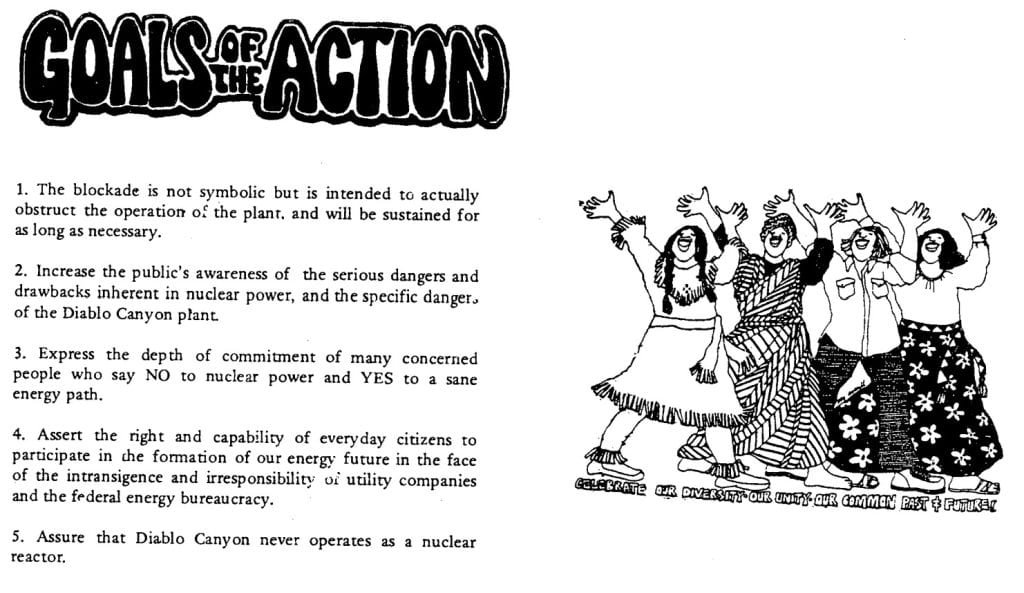
Abalone Alliance, “Declaration of Nuclear Resistance,” 1978
In 1965, the utility company Pacific Gas & Electric announced plans to construct a multi-reactor generating station at Diablo Canyon, near San Luis Obispo, California. The Abalone Alliance used a variety of non-violent, direct-action techniques to oppose the plant and slow its construction, including marches, sit-ins, and blockades. How does this flyer seek to challenge the conventional wisdom in the 1970s about the country’s energy needs?
Additional Reading
Balogh, Brian. Chain Reaction: Expert Debate and Public Participation in American Commercial Nuclear Power 1945–1975. New York: Cambridge University Press, 1991.
Brown, Kate. Plutopia: Nuclear Families, Atomic Cities, and the Great Soviet and American Plutonium Disasters. New York: Oxford University Press, 2015.
Boyer, Paul. By the Bomb’s Early Light: American Thought and Culture at the Dawn of the Atomic Age. Chapel Hill: University of North Carolina Press, 2005.
Feldman, James. Nuclear Reactions: Documenting American Encounters with Nuclear Energy. Seattle: University of Washington Press, 2016.
Hamblin, Jacob Darwin. The Wretched Atom: America’s Global Gamble with Peaceful Nuclear Technology. New York: Oxford University Press, 2021.
Intondi, Vincent. African Americans Against the Bomb: Nuclear Weapons, Colonialism, and the Black Freedom Movement. Stanford, CA: Stanford University Press, 2015.
Iversen, Kristen. Full Body Burden: Growing Up in the Nuclear Shadow of Rocky Flats. New York: Crown, 2013.
Knoblauch, William M. Nuclear Freeze in a Cold War: The Reagan Administration, Cultural Activism, and the End of the Arms Race. Boston: University of Massachusetts Press, 2017.
Masco, Joseph. The Nuclear Borderlands: The Manhattan Project in Post-Cold War New Mexico. Princeton, NJ: Princeton University Press, 2006.
Melosi, Martin V. Atomic Age America. New York: Routledge, 2016.
Robey, Sarah. Atomic Americans: Citizens in a Nuclear State. Ithaca, NY: Cornell University Press, 2022.
Wills, John. Conservation Fallout: Nuclear Protest at Diablo Canyon. Reno: University of Nevada Press, 2012.
Author Bio
Dr. Jim Feldman is an environmental historian whose teaching and research interests include American and global environmental history, wilderness and National Park Service policy, radioactive waste policy and management, and campus sustainability. He has explored these subjects in two books: “A Storied Wilderness: Rewilding the Apostle Islands” and “Nuclear Reactions: Documenting American Encounters with Nuclear Energy.” He is currently an active member of the FORWAR+DS in Place project, in which he is exploring the history of the PCB cleanup in the Fox River.
